The universe we see is only the very tip of the vast cosmic iceberg.
The hundreds of billions of galaxies it contains, each of them home to billions of stars, planets and moons as well as massive star-and-planet-forming clouds of gas and dust, and all of the visible light and other energy we can detect in the form of electromagnetic radiation, such as radio waves, gamma rays and X-rays — in short, everything we’ve ever seen with our telescopes — only amounts to about 5% of all the mass and energy in the universe.
Along with this so-called normal matter there is also dark matter, which can’t be seen, but can be observed by its gravitational effect on normal, visible matter, and makes up another 27% of the universe. Add them together, and they only total 32% of the mass of the universe — so where’s the other 68%?
Dark energy.
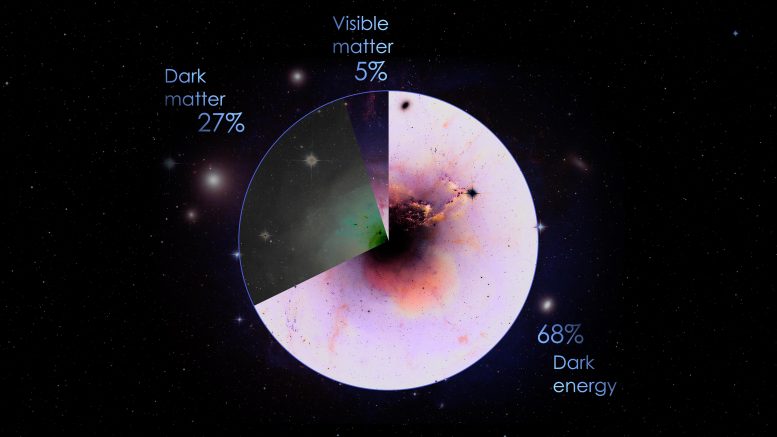
This pie chart shows rounded values for the three known components of the universe: normal matter, dark matter, and dark energy. Credit: NASA’s Goddard Space Flight Center
So what exactly is dark energy? Put simply, it’s a mysterious force that’s pushing the universe outward and causing it to expand faster as it ages, engaged in a cosmic tug-of-war with dark matter, which is trying to pull the universe together. Beyond that, we don’t yet understand what dark energy is, but Penn State astronomers are at the core of a group that’s aiming to find out through a unique and ambitious project 16 years in the making: HETDEX, the Hobby-Eberly Telescope Dark Energy Experiment.
“HETDEX has the potential to change the game,” said Associate Professor of Astronomy and Astrophysics Donghui Jeong.
Dark energy and the expanding universe
Today there is consensus among astronomers that the universe we inhabit is expanding, and that its expansion is accelerating, but the idea of an expanding universe is less than a century old, and the notion of dark energy (or anything else) accelerating that expansion has only been around for a little more than 20 years.
In 1917 when Albert Einstein applied his general theory of relativity to describe the universe as a whole, laying the foundations for the big bang theory, he and other leading scientists at that time conceived of the cosmos as static and nonexpanding. But in order to keep that universe from collapsing under the attractive force of gravity, he needed to introduce a repulsive force to counteract it: the cosmological constant.
It wasn’t until 1929 when Edwin Hubble discovered that the universe is in fact expanding, and that galaxies farther from Earth are moving away faster than those that are closer, that the model of a static universe was finally abandoned. Even Einstein was quick to modify his theories, by the early 1930s publishing two new and distinct models of the expanding universe, both of them without the cosmological constant.
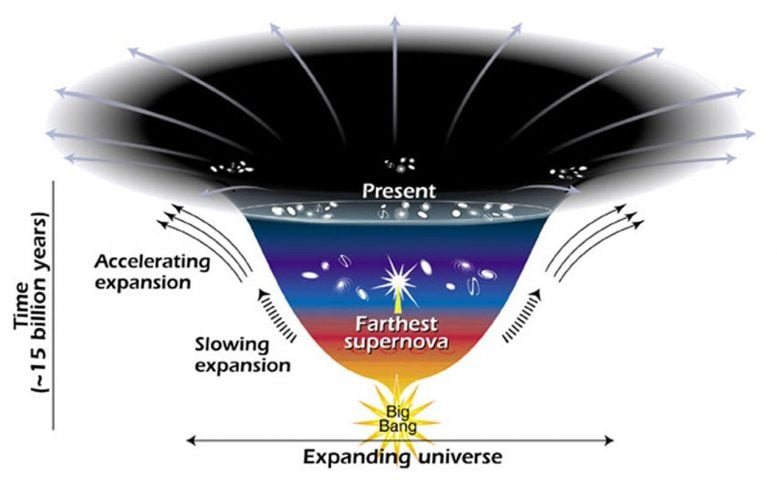
This diagram shows the changes in the rate of expansion since the universe’s birth. The shallower the curve, the faster the rate of expansion. The curve changes noticeably about 7.5 billion years ago, when objects in the universe began flying apart at a faster rate. Astronomers theorize that the faster expansion rate is due to a mysterious force — dark energy — that is pulling galaxies apart. Credit: Ann Feild (STScI)
But although astronomers had finally come to understand that the universe was expanding, and had more or less abandoned the concept of the cosmological constant, they also presumed that the universe was dominated by matter and that gravity would eventually cause its expansion to slow; the universe would either continue to expand forever, but ever-increasingly slowly, or it would at some point cease its expansion and then collapse, ending in a “big crunch.”
“That’s the way we thought the universe worked, up until 1998,” said Professor of Astronomy and Astrophysics Robin Ciardullo, a founding member of HETDEX.
That year, two independent teams — one led by Saul Perlmutter at Lawrence Berkeley National Laboratory, and the other led by Brian Schmidt of the Australian National University and Adam Riess of the Space Telescope Science Institute — would nearly simultaneously publish astounding results showing that the expansion of the universe was in fact accelerating, driven by some mysterious antigravity force. Later that year, cosmologist Michael Turner of the University of Chicago and Fermilab coined the term “dark energy” to describe this mysterious force.
The discovery would be named Science magazine’s “Breakthrough of the Year” for 1998, and in 2011 Perlmutter, Schmidt, and Reiss would be awarded the Nobel Prize in physics.
Competing theories
More than 20 years after the discovery of dark energy, astronomers still don’t know what, exactly, it is.
“Whenever astronomers say ‘dark,’ that means we don’t have any clue about it,” Jeong said with a wry grin. “Dark energy is just another way of saying that we don’t know what’s causing this accelerating expansion.”
There are, however, a number of theories that attempt to explain dark energy, and a few major contenders.
Perhaps the most favored explanation is the previously abandoned cosmological constant, which modern-day physicists describe as vacuum energy. “The vacuum in physics is not a state of nothing,” Jeong explained. “It is a place where particles and antiparticles are continuously created and destroyed.” The energy produced in this perpetual cycle could exert an outward-pushing force on space itself, causing its expansion, initiated in the Big Bang, to accelerate.
Unfortunately, the theoretical calculations of vacuum energy don’t match the observations — by a factor of as much as 10120, or a one followed by 120 zeroes. “That’s very, very unusual,” Jeong said, “but that’s where we’ll be if dark energy turns out to be constant.” Clearly this discrepancy is a major issue, and it could necessitate a reworking of current theory, but the cosmological constant in the form of vacuum energy is nonetheless the leading candidate so far.
As a result of its design, HETDEX is collecting a massive amount of data, extending well beyond its intended targets and providing additional insights into things like dark matter and black holes, the formation and evolution of stars and galaxies, and the physics of high-energy cosmic particles such as neutrinos.
Another possible explanation is a new, yet-undiscovered particle or field that would permeate all of space; but so far, there’s no evidence to support this.
A third possibility is that Einstein’s theory of gravity is incorrect. “If you start from the wrong equation,” Jeong said, “then you get the wrong answer.” There are alternatives to general relativity, but each has its own issues and none has yet displaced it as the reigning theory. For now, it’s still the best description of gravity we’ve got.
Ultimately, what’s needed is more and better observational data — precisely what HETDEX was designed to collect like no other survey has done before.
A map of stars and sound
“HETDEX is very ambitious,” Ciardullo said. “It’s going to observe a million galaxies to map out the structure of the universe going over two-thirds of the way back to the beginning of time. We’re the only ones going out that far to see the dark energy component of the universe and how it’s evolving.”
Ciardullo, an observational astronomer who studies everything from nearby stars to faraway galaxies and dark matter, is HETDEX’s observations manager. He’s quick to note, though, that he’s got help in that role (from Jeong and others) and that he and everyone else on the project wears more than one hat. “This is a very big project,” he said. “It’s over $40 million. But if you count heads, it’s not very many people. And so we all do more than one thing.”
Jeong, a theoretical astrophysicist and cosmologist who also studies gravitational waves, was instrumental in laying the groundwork for the study and is heavily involved in the project’s data analysis — and he’s also helping Ciardullo determine where to point the 10-meter Hobby-Eberly Telescope, the world’s third largest. “It’s kind of interesting,” he noted with a chuckle, “a theorist telling observers where to look.”
“We’re the only ones going out that far to see the dark energy component of the universe and how it’s evolving.”
— Robin Ciardullo, Penn State professor of astronomy and astrophysics
While other studies measure the universe’s expansion using distant supernovae or a phenomenon known as gravitational lensing, where light is bent by the gravity of massive objects such as galaxies and black holes, HETDEX is focused on sound waves from the Big Bang, called baryonic acoustic oscillations. Although we can’t actually hear sounds in the vacuum of space, astronomers can see the effect of these primordial sound waves in the distribution of matter throughout the universe.
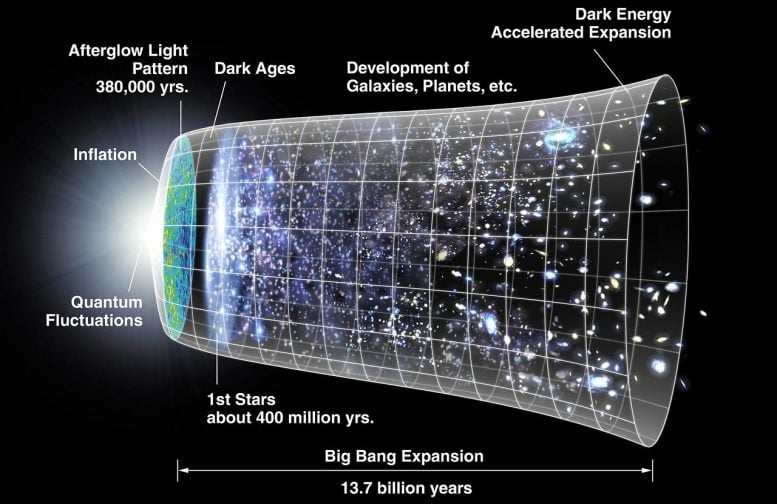
In this representation of the evolution of the universe, the far left depicts the earliest moment we can now probe, when a period of “inflation” produced a burst of exponential growth. The afterglow light (known as the cosmic microwave background) was emitted about 375,000 years after inflation and has traversed the universe largely unimpeded since then. The conditions of earlier times are imprinted on this light, which also forms a backlight for later developments of the universe. Credit: NASA/WMAP Science Team
During the first 400,000-or-so years following the Big Bang, the universe existed as dense, hot plasma — a particle soup of matter and energy. Tiny disturbances called quantum fluctuations in that plasma set off sound waves, like ripples from a pebble tossed into a pond, which helped matter begin to clump together and form the universe’s initial structure. The result of this clumping is evident in the cosmic microwave background (also called the “afterglow” of the big bang), which is the first light, and the farthest back, that we can see in the universe. And it’s also imprinted in the distribution of galaxies throughout the universe’s history — like the ripples on our pond, frozen into space.
“The physics of sound waves is pretty well known,” Ciardullo said. “You see how far these things have gone, you know how fast the sound waves have traveled, so you know the distance. You have a standard ruler on the universe, throughout cosmic history.”
As the universe has expanded so has the ruler, and those variances in the ruler will show how the universe’s rate of expansion, driven by dark energy, has changed over time.
“Basically,” Jeong said, “we make a three-dimensional map of galaxies and then measure it.”
New discovery space
To make their million-galaxy map, the HETDEX team needed a powerful new instrument.
A set of more than 150 spectrographs called VIRUS (Visible Integral-Field Replicable Unit Spectrographs), mounted on the Hobby-Eberly Telescope, gathers the light from those galaxies into an array of some 35,000 optical fibers and then splits it into its component wavelengths in an ordered continuum known as a spectrum.
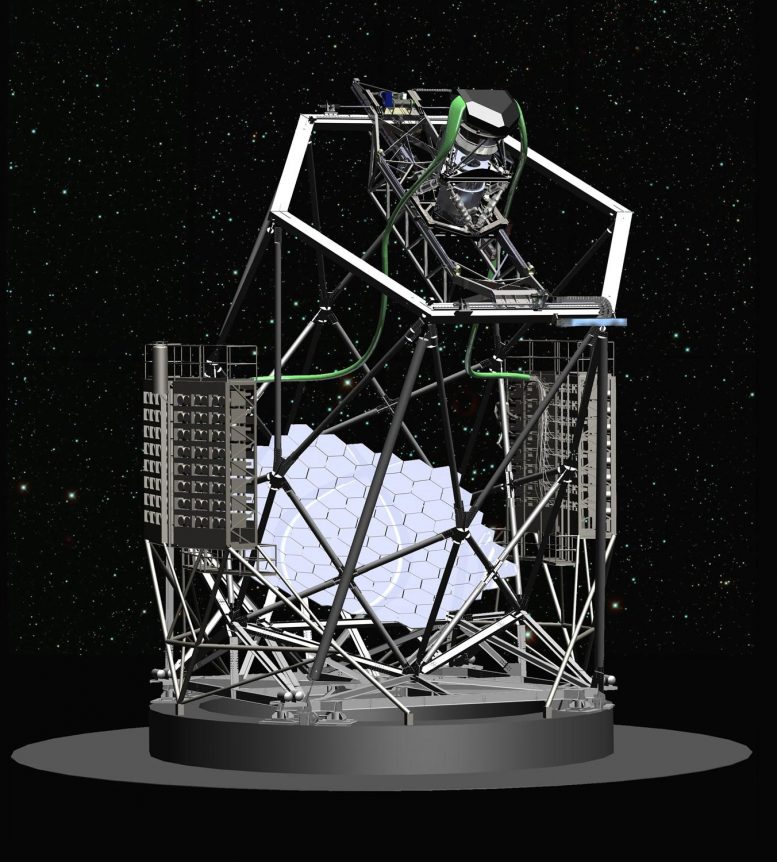
In preparation for HETDEX, the Hobby-Eberly Telescope received a number of upgrades — including a new tracking system and the VIRUS spectrograph, shown here in this concept illustration. Credit: McDonald Observatory/HETDEX Collaboration
Galaxies’ spectra reveal, among other things, the speed at which they are moving away from us — a measurement known as “redshift.” Due to the Doppler effect, the wavelength of an object moving away from its observer is stretched (think of a siren that gets lower in pitch as it speeds away), and an object moving toward its observer has its wavelength compressed, like that same siren increasing in pitch as it gets nearer. In the case of receding galaxies, their light is stretched and thus shifted toward the red end of the spectrum.
Measuring this redshift allows the HETDEX team to calculate the distance to those galaxies and produce a precise three-dimensional map of their positions.
Among the galaxies HETDEX is observing are what are known as Lyman-alpha galaxies — young star-forming galaxies that emit strong spectral lines at specific ultraviolet wavelengths.
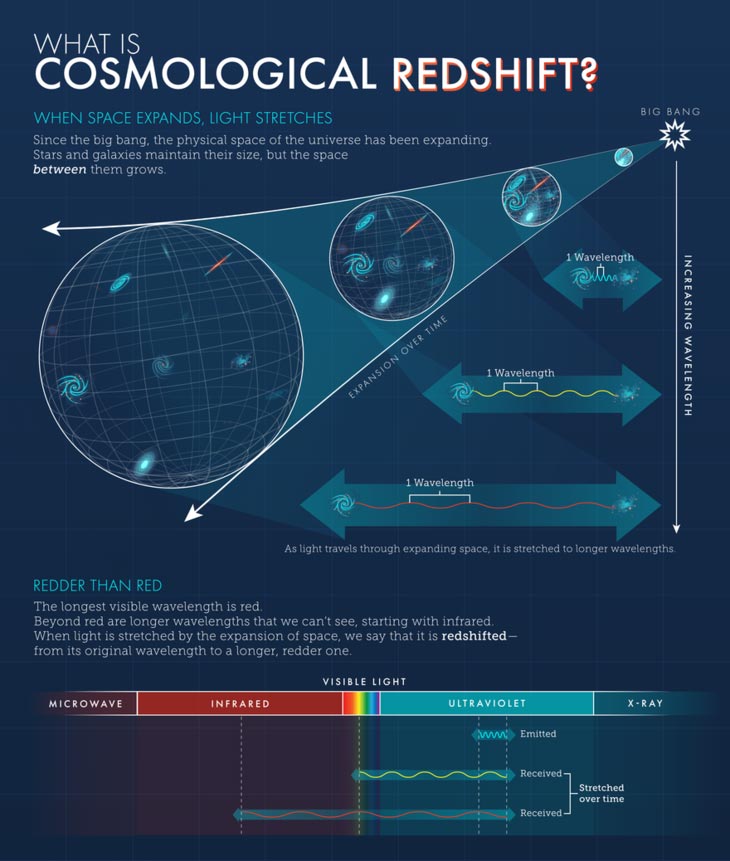
The universe is expanding, and that expansion stretches light traveling through space in a phenomenon known as cosmological redshift. The greater the redshift, the greater the distance the light has traveled. As a result, telescopes with infrared detectors are needed to see light from the first, most distant galaxies. Credit: NASA, ESA, AND L. Hustak (STSci)
“We’re using Lyman-alpha-emitting galaxies as a ‘tracer particle,’” explained Research Professor of Astronomy and Astrophysics Caryl Gronwall, who is also a founding member of HETDEX. “They’re easy to find because they have a very strong emission line, which is easy to find spectroscopically with the VIRUS instrument. So we have this method that efficiently picks out galaxies at a fairly high redshift, and then we can measure where they are, measure their properties.”
Gronwall, who along with Ciardullo has been studying Lyman-alpha galaxies for nearly 20 years, leads HETDEX’s efforts in this area, while Associate Professor of Astronomy and Astrophysics Derek Fox lends his expertise to calibrating the VIRUS instrument, using incidental observations of stars with well-known properties to fine-tune its spectra.
“Every shot we take with HETDEX, we observe some stars on the fibers,” Fox explained. “That’s an opportunity, because the stars are telling you how sensitive your experiment is. If you know the brightness of the stars and you see the data that you collect on them, it offers an opportunity to keep your calibration on point.”
“HETDEX has the potential to change the game.”
— Donghui Jeong, Penn State associate professor of astronomy and astrophysics
One of HETDEX’s biggest strengths is that it was designed as a blind survey — observing broad swaths of sky instead of specific, predetermined objects. “Nobody has tried doing a survey like this before,” Ciardullo said. “It’s always ‘Find your objects, then do the spectroscopy.’ We’re the first ones to try to do a whole lot of spectroscopy and then figure out what we saw.”
As a result of this design, HETDEX is collecting a massive amount of data, extending well beyond its intended targets and providing additional insights into things like dark matter and black holes, the formation and evolution of stars and galaxies, and the physics of high-energy cosmic particles such as neutrinos.
“That’s very different and very interesting,” Jeong said. “We have huge discovery space.”
Ciardullo added, “One thing you can infer — if you first have to see an object before pointing your spectroscope there, well that’s fine, but it requires that the object be able to be seen. HETDEX can observe spectra of things that you can’t see.”
This means that in addition to the known data it’s collecting, HETDEX is opening a window to unexpected findings, discoveries yet unforeseen. “We will be a pathfinder for more experiments,” Ciardullo said, and that sentiment is echoed by others on the team, including Fox.
“We’re definitely going to be blazing trails out there,” he said. “There’s big, big potential for really exciting discoveries.”
Back to roots, and beyond
The futuristic science of HETDEX is, in a strange twist, very much in line with the ideas that drove the development of the Hobby-Eberly Telescope (HET) nearly 40 years ago.
“HET was initially conceived as the Penn State Spectroscopic Survey Telescope,” explained Professor Emeritus of Astronomy and Astrophysics Larry Ramsey, who invented the telescope in 1983 with then Penn State colleague Dan Weedman, and later served as chairman of the HET’s board of directors. “The original mission was to conduct spectroscopic surveys, and in the almost 20 years between when we first dedicated the telescope and when we started HETDEX, the telescope was not really doing surveys. So in a very real sense HETDEX is taking the HET back to its roots, and it has grown into a really interesting project.”
“The scale of this survey is very futuristic, even now,” Jeong said. Recalling a recent cosmology conference, he related a discussion about the future of galactic surveys. “I sat there and listened, and it was basically what we’re doing,” he said. “HETDEX is a future survey that exists now.”
In addition to what HETDEX discovers about dark energy, the data it’s collecting will also provide fodder for future studies far beyond the scope of its own mission. And chances are, HETDEX will continue doing “spacebreaking” science on the distant, high-redshift universe for quite a few years to come.
“Even currently planned future surveys don’t go beyond HETDEX,” Jeong said. “I think we will still be at the forefront, even 10 years from now.”

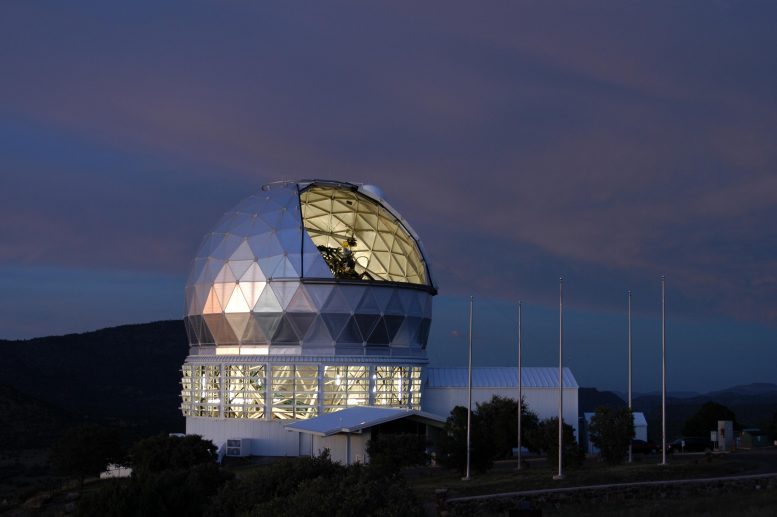






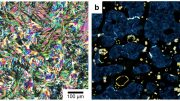

Another way to explain Dark Energy is suggested by String Theory. All matter and energy, including photons (light), have vibrating strings as their basis.
String and anti-string pairs are speculated to be created in the quantum foam, a roiling energy field suggested by quantum mechanics, and they immediately annihilate each other. If light passes near these string/anti-string annihilations, perhaps some of that annihilation energy is absorbed by the string in the light. Then the Fraunhofer lines in that light will move a bit towards the blue and away from the red shift. As this continues in an expanding universe we get the same curve displayed by Perlmutter and colleagues at their Nobel Prize lecture, without the need for Dark Energy.
This speculation has the universe behaving in a much more direct way. Specifics can be found in my YouTube https://www.youtube.com/watch?v=epk-SMXbu1c
You know the drill: that is self promotion and linking to pseudoscience.
No other theory can touch the general relativistic ΛCDM model. The recent completed SDSS-IV extended Baryon Oscillation Spectroscopic Survey has released several results, but the strongest may be that dark energy is tested beyond reasonable doubt.
“By combining BAO and RSD, the team confirmed the existence of dark energy to a stunning confidence level of 11-Sigma. Typically, a scientific result to 5-Sigma is taken as confirmation. A result at 11-Sigma is so strong it is about as close to certainty that we can get. Dark energy and the accelerating expansion it drives is definitely real.”
[ https://www.universetoday.com/151042/11-sigma-detection-of-dark-energy-comes-from-measuring-over-a-million-extremely-distant-galaxies/ ]
Now you need evidence for strings in relation to dark energy. Not the many evidences against such that it only works in non-flat (negative curvature), non-positive vacuum energy space (which is funny if you claim it predicts the observed positive dark energy value), or that it didn’t give natural thermal WIMPs in LHC. No, you need to beat the 11-sigma evidence that dark energy exist.
I read this article and I am left with the thought that everything now known about the Universe falls into the realm of the impossible and the unbelievable from the point of view of our present understanding of things and most of what we know. I hope this impression is only because of my ignorance.
Likely. The experts see that these observations work with the models and vice versa.
[And I agree after perusing a few of the latest results, with a helpful cosmology MOOC to get me up to speed in the aspect of interested bystander. It isn’t rocket science!]
I’m also untrained in Astrophysics, and I have a basic confusion: If galaxies are moving away faster when they are farther away from us (and farther back in time), and they are moving away slower when they are closer to us in distance (and closer in time), then doesn’t that argue for the universe’s expansion to be slowing, not speeding up? Help me understand!
The best measurement used by astronomers for the speed galaxies are moving is the displacement of Fraunhofer lines in Type 1a supernova, which didn’t seem to be the way they expected. Saul Perlmutter, in his Nobel Prize Lecture, said:
The best fit curve was decelerating for about the first seven billion years, and then accelerating for the most recent approximately seven billion years. This was the surprising result the supernovae were showing us.
A view of String Theory shows otherwise, as in my YouTube https://www.youtube.com/watch?v=epk-SMXbu1c
You know the drill: that is self promotion and linking to pseudoscience.
That is a good question!
Basically the answer is that galaxies don’t move (on that scale), it is space that expands – see the light being stretched in the last figure above.
But the easiest visualisation may be the one used in, say, this article on myths (and confusions) about big bang.
“But the Big Bang itself doesn’t work the way most people think. Here are the top 5 myths that people believe about the Big Bang.
1.) The Big Bang is the explosion that began our Universe.
Every time we look out at a distant galaxy in the Universe and try to measure what its light is doing, we see the same pattern emerge: the farther away the galaxy is, the more significantly its light is systematically shifted to longer and longer wavelengths. This redshift that we observe for these objects follows a predictable pattern, with double the distance meaning that the light is shifted by twice as much.
Distant objects, therefore, appear to be receding away from us. Just as a police car speeding away from you will sound lower-pitched the faster it moves away from you, the greater we measure an object’s distance to be from us, the greater the measured redshift of its light will be. It makes a lot of sense, then, to think that the more distant objects are moving away from us at faster speeds, and that we could trace every galaxy we see today back to a single point in the past: an enormous explosion.
But this is a total misconception about what the Big Bang actually is. It isn’t that these galaxies are moving through the Universe itself, but rather that the fabric of space that makes up the Universe itself is expanding. Just as raisins appear to recede in proportion to their distance in a leavening ball of dough, the galaxies appear to recede from one another as the Universe expands. The raisins aren’t in motion relative to the dough; the action of the expanding dough itself simply appears to drive them apart.”
“2.) There is a point in space that we can trace the Big Bang ‘event’ back to.
Similarly, there’s no “center point” to the event of the Big Bang. You might initially think that if everything appears to be expanding away from everything else, then we can extrapolate everything back to when they all originated at the same location. Just as a grenade has a central location from where all the shrapnel must have originated, it makes sense to think the Universe must have had a similar point of origin.
But the Universe didn’t explode; it just expanded. In an expanding Universe, every location in space looks the same, when you consider a large-enough volume of it. On the large-scale average, the Universe appears to have the same density, the same temperature, and the same number of galaxies everywhere. And if you extrapolate it back in time, it will appear hotter and denser, but that’s because space itself is evolving and expanding, too.”
[ https://www.forbes.com/sites/startswithabang/2020/02/06/the-top-5-myths-you-probably-believe-about-the-big-bang/?sh=1ebafa002694 – see the moving gif illustrating what one observer sees.]
The un-observable universe is 68% larger than the observable universe. Problem solved.
Explanation for above: The observable universe is the area around us fro which the emanating light has had time to reach us. I’m saying the ACTUAL universe, outside that boundary,is 68% larger. So we don’t need dark energy. But I’ll take a cup if somebody’s pouring.
I’m not sure what you mean you have solved!? The observable universe is precisely that, a volume that contains all the light that has had time to reach us.
Usually I would ask for quantification of claims at this point, but since you seem to suggest that light in vacuum travels faster than light in vacuum does I think you self refuted your claim.
Oh, maybe you suggest that it is about balancing energy content!? If it was that easy, scientists would have suggested it long ago, one would hope.
First, dark energy affects our universe uniformly. How do you ensure that?
Second, you suggest a not observed inhomogeneous universe which is set up to give only us a funny view of it but everyone else would see different “universes”. That is so unlikely that it would be a hard sell.
Third, what would you fill the rest of the universe with, and why?
…”Dark Energy Experiment 16 Years in the Making Could Illuminate Origin, Evolution, Fate of Universe”
The most important word is “Could” and that could lead to a years of guesses…
It is those sound waves [Baryonic Acoustic Oscillations or BAO] that has allowed another galaxy survey collaboration to test dark energy beyond reasonable doubt.
“By combining BAO and RSD, the team confirmed the existence of dark energy to a stunning confidence level of 11-Sigma. Typically, a scientific result to 5-Sigma is taken as confirmation. A result at 11-Sigma is so strong it is about as close to certainty that we can get. Dark energy and the accelerating expansion it drives is definitely real.”
[“11-Sigma Detection of Dark Energy Comes From Measuring Over a Million Extremely Distant Galaxies”, Universe today; commenting on Gong-Bo Zhao, et al. “The completed SDSS-IV extended Baryon Oscillation Spectroscopic Survey: a multitracer analysis in Fourier space for measuring the cosmic structure growth and expansion rate.” Monthly Notices of the Royal Astronomical Society 504.1 (2021): 33-52.]
Also notable is that another of the collaboration papers nearly empties out the observational space on flat space.
Its preprint version notes on BAO that it “allow constraints on curvature that are now roughly one order of magnitude within the detectable limit of σ(Ω_k) ∼ 0.0001″.
And they see Weinberg’s multiverse, which a natural consequence of eternal inflation of the type seen by the Planck collaboration 2018 in the cosmic background spectra, realized as a strong candidate for predicting the observed value of a flat space and the vacuum energy:
“Nevertheless, the observed consistency with flat ΛCDM at the higher precision of this work points increasingly towards a pure cosmological constant solution, for example, as would be produced by a vacuum energy finetuned to have a small value. This fine-tuning represents a theoretical difficulty without any agreed-upon resolution and one that may not be resolvable through fundamental physics considerations alone (Weinberg 1989; Brax & Valageas 2019). This difficulty has been substantially sharpened by the observations presented here.”
[“Completed SDSS-IV extended Baryon Oscillation Spectroscopic Survey: Cosmological implications from two decades of spectroscopic surveys at the Apache Point Observatory”, Shadab Alam et al., Phys. Rev. D 103, 083533 – Published 28 April 2021.]
Speaking of inflation, which was discovered earlier than dark energy at about 40 years ago, all the three cosmology illustrations gives an outdated view.
“Inflation came first, and its end heralded the arrival of the Big Bang. There are still those who disagree, but they’re now nearly a full 40 years out of date.”
[“What Came First: Inflation Or The Big Bang?”, Forbes]
Just a dim theory I have here but, what if the universe is not speeding up in the sense velocity, but in time? The early universe was very dense/compact with all the matter we now see. That much matter in such a (relative) small area could be slowing down TIME like a black hole does. Since the universe is expanding that mass is getting more and more spread out and allowing it to speed up in time. So galaxies may only appear to be racing away at break-neck speeds, they may actually only be catching up with the speed of time and were still slowly creeping along.
Of course this theory is likely completely wrong but I thought I would put it out there. Maybe someone else has already posted it???? I’m not an astronomer nor a physicist I’m just a science enthusiast curious about all things space related.
F =G Mm /r^2
M is the mass of the Center of Our Universe
m is the mass of the galaxy
Galaxies are born in the center of the universe:
https://www.youtube.com/watch?v=tFUM3vAlaGc
With each galaxy born, the mass of the center of the universe decreases, and the total mass of all galaxies increases. In the first born galaxy, the first cosmic velocity is greater because the mass of the Center of the Universe is greater, and the first cosmic velocity of the last galaxy is m n less, because the mass of the center of the Universe has become smaller M – m2-m2 – m3 -… mn.
Therefore, the first galaxies have a higher speed and with the fall of the mass of the center of the universe move away even faster without any dark energy.
This whole comment comes up as pseudoscience based on myths on big bang. Myths that I have already referenced in my reply to Steve Schlich so go there for description of and references to the actual science – having read the thread this attempt to muddy the waters shouldn’t have been attempted (one would think).
Accordingly we can guess that the link goes to such pseudoscience and is likely self-promotion of a personal brand of erroneous claims.
Thanks for the link ,Torbjörn. I am increasingly convinced that modern astronomy is a pseudoscience that has been standing still for 100 years, and if it sees something in telescopes, it does not understand anything.
Your baseless claim that science – with its literary 100,000s of experts having worked for centuries – is a pseudoscience falls flat.
Especially here, since it was a reaction to having your pseudoscience revealed.
It is a fact that the early universe was very dense – and so hot, with lots of kinetic energy to add to the general relativistic description – but if there were any relativistic effects they do not show up in the cosmic background radiation imprint much later. We lack evidence of them and added to that they would have had fleeting influence.
Your submit was a fantastic reminder of why I like studying weblogs. It is fantastic to view somebody so obsessed with their subject matter.